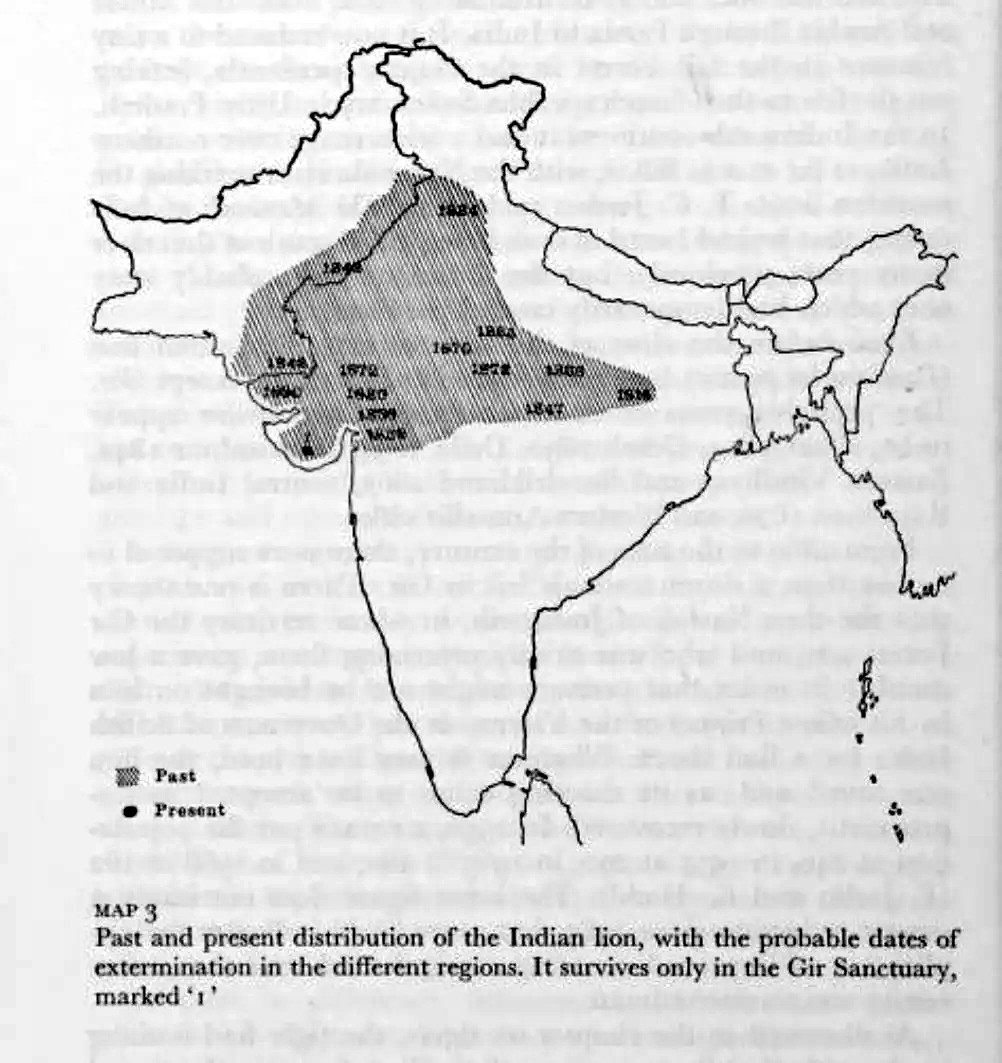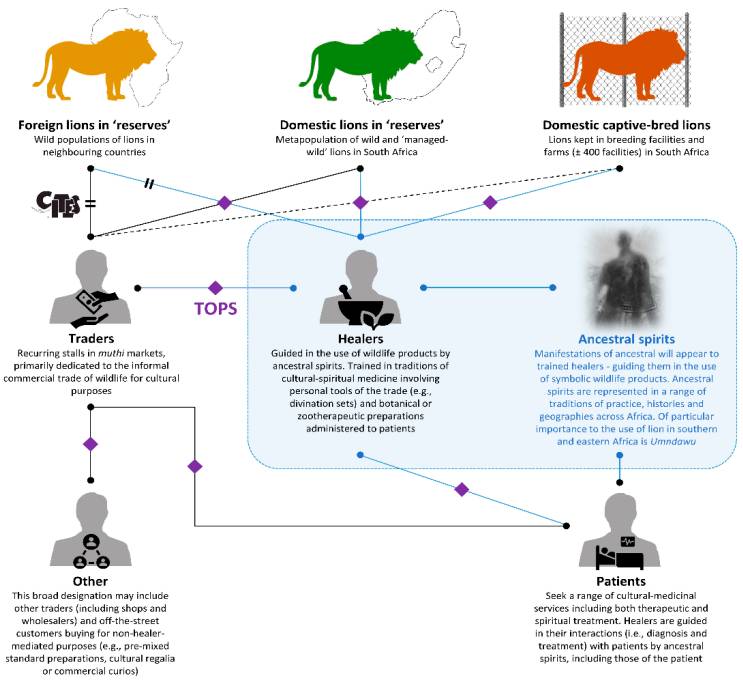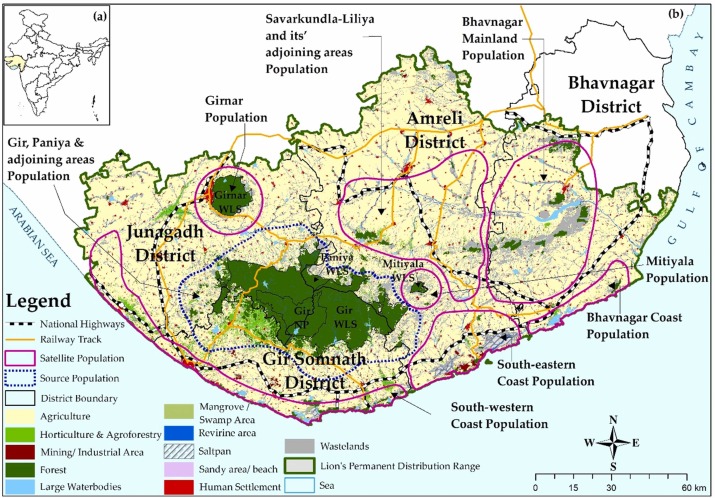Discover the use of lion parts and products in the history and heritage of medical practices of ethnic groups of India and in traditional African medicine.
In this Article

Lions would have once been abundant through large parts of India and Pakistan.
Unfortunately, they were hunted to almost extinction.
Lion hunting was often part of elaborate court ceremonies and festivities, reinforcing social hierarchies and the grandeur of the royals, like the Chandragupta, the Chandelas, the Hoysalas, the Mughal Empire and Rajput kings.
It is only thanks to the Nawab of Junagarh that the population was not completely wiped out, as he took measures to ensure the preservation of the species.
Due to continued conservation initiatives since the end of the 19th century, the Asiatic lion (Panthera Leo Persica) population in Sasan-Gir National Park and protected Saurashtra’s Gir forest of India has rebounded to over 600 individuals, making it a successful example of wildlife conservation.

The lion is protected in India, and so are its products.
Animal-based traditional medicine is a conservation threat, along with the loss of habitat, for the only lion population of India.
ETHNOMEDICINE: The use of lion products in history and heritage of traditional Indian medicine
Since its origin, humankind has relied on animal-based traditional medicine (ethnomedicine), for their health care. Ethnozoology or zootherapy essentially deals with the interrelationship between humans and animals, especially the medicinal applications of animals.
The use of medicines obtained from big cats in Aisia is suggested as a cure for ailments ranging from rheumatism to tubercolosis.
Ayurveda and the lion
In India, since times immemorial, there has been a deep and rich understanding and documentation of animals during the Samhita period. Animal parts and their products were used for medicine, making instruments for surgical management and even in diagnosis. There are innumerable instances to show the understanding of animal life in Indian medical traditions.
Ayurveda is the traditional medical science of India, literally meaning ‘Science of Life’, combining the two words, ‘Ayu’ meaning life and ‘Veda’ meaning knowledge. Ayurveda makes extensive use of animal products in different formulations used for preventive and curative medicine.
Caraka Samhita, the oldest available Ayurvedic classic, mentions 230 types of animals – the majority of these references pertain to animal use as food and medicine.

The Siṃha सिंह or Siṃhagati (lion) is described as Kapha Constitution. The meat of the lion is part of the māṃsavarga (‘group of flesh’), which is used throughout Ayurvedic literature.
The Aryans from Middle-east Asia, found both the big cats in plenty in the Gangetic valley. They denoted both of them with a common word “Singha”. The existence of interchangeable names for lions and tigers does gives us a look into the past where both of these cats used to occur in the same landscape. But also suggests that both cats were exchangeably used for deviation and as medicine.
The lion and the tiger are grouped as Prasaha प्रसह Varga, animals or birds who take their food by snatching. Qualities of the food obtained from the meat of those tat eat by snatching (Prasaha) are:
- Guru – heavy,
- Ushna – hot in potency,
- Snigdha – unctuous, oily
- Madhura – sweet,
- Balavardhana – improves strength and immunity
- Upachaya vardhana – improves body nourishment, plumpness
- Vrushya – aphrodisiac
- Vatahara – Balances Vata and increases Kapha and Pitta.
It is useful for people who do daily exercise and for those having good digestion strength.
The flesh of meat- eating animals (Prasaha) is specially useful for patients suffering from chronic piles (Arsha – Hemorrhoids), Grahani – Malabsorption syndrome, Irritable Bowel Syndrome and Shosha –emaciation.
The Charaka Samhita lists the meat of lion, bear and tiger as highly potent for tuberculosis patients.

Much of the animal-related knowledge found in Ayurvedic classics appears to have been drawn from the rich folk traditions passed down orally through generations.
A vast body of wisdom has survived into modern times through folklore, as numerous practices became embedded in the cultural traditions of tribal communities.
Lion in medicinal practices of ethnic communities of India
Although revered and protected by the taboos of some tribal groups, during its long association with the people of Asia the lion has been hunted for sport and killed to protect humans and livestock.
Much of India’s indigenous medicine uses medicinal plants, minerals and animal parts and extracts as remedies for various ailments.
The Zoological Survey of India undertook a study of tribal medicines, (Ethnozoological knowledge of Indian scheduled tribe, scheduled caste and rural communities) and found, that:
The Lion is not eaten in India.
The pelt, Teeth, Liver and Claw is used traditionally.
Some have been poached for their claws, which are used as good luck charms, but they have not been under as much threat as the tiger.
Until now.
In Indian tribal medicine and magico-religious practices, the fat derived from more than 15 animals is used.
Among these, tiger and lion fat are particularly regarded as potent remedies, especially effective in alleviating various types of pain, including rheumatic pain.
Lion body parts in traditional medicine of West Africa

CC-BY-4.0, edited.
The African lion (Panthera Leo Leo) is present in West- and northern Central Africa. Lions are restricted to fragmented and isolated declining populations but are not endangered (yet).
African lions are not currently classified as endangered, they are listed as vulnerable by the International Union for Conservation of Nature (IUCN).
When wild game was still plentiful, animal claws would have been used to punctuate beaded prestige necklaces. Lion-claw necklaces were the exclusive property of royalty while the bone imitations were owned and worn by high-ranking individuals of lesser status in Zulu culture.

Body ornaments made of lion claws have been worn in many cultures as charms or amulets.
These lion’s claws from East Africa, which have been mounted on a chain, are an example of an amulet designed to protect the wearer.
It was collected in East Africa in the 1880s.
Called iBhubese in Zulu and iNgwenyama in Xhosa, Lion body parts and derivatives are used in African traditional medicine (“muthi”) preparations and have routinely been recorded in South African muthi market surveys since the 1980s.

Lion “fat” (most of it imitation) is most prevalent in the markets compared to the skin and bones.
Lions are used symbolically for their power, strength, and nobility.
There is believed to be a limited demand for lion derivatives by traditional healers outside urban markets in the rural areas. Healers routinely use pairs of bones (usually the phalanges) as instruments of divination. Traditional health practitioners across Africa use lion body parts in rituals and divination, mainly because they exemplify strength and fear.

The drivers of cultural – medicinal demand for lions, as find in Coals, P. G. R., Mbongwa, N. S., Naude, V. N., & Williams, V. L. Contemporary Cultural Trade of Lion Body Parts. Animals, 12(22). 2022.

Traditional medicine (muthi) system diagram illustrating lion body-part trade and use linkages between stakeholders, with the inclusion of ancestral spirits (primarily, but not limited to, umndawu) as adjunct stakeholders and ‘gatekeepers’ mediating lion part use and trade.
Solid lines indicate relationships revealed by responses to this survey; dotted lines represent relationships not revealed in responses to this survey but which have been previously recorded in the literature; blue lines indicate interactions gatekept and mediated by ancestral spirits; parallel bars indicate trade requiring CITES permits—in this system all trade is contrary to CITES; purple diamonds indicate trade and possession requiring a TOPS permit—not all trade in this system is necessarily in contravention of TOPS permitting.
Lion (Patera Leo Leo) in tribal medicine and magico-religious practices in West Africa
This Table indicates 22 lion body parts utilized for healing and preventive medicine in the three provinces surrounding Yankari Game Reserve.
| Lion body parts used | Main uses |
| Fat | Dislocation, fracture, broken bone, back pain, rheumatism, joint pain, ‘bone marrow pain’, protection against spiritual attack |
| Skin | Protection from evil sprits, whooping cough, self empowerment, child protection unspecified from convulsions |
| Bone | Rheumatism, joint pain, bone marrow pain, bone fractures, back pain |
| Meat | Nutrition, increase general health |
| Teeth | Protection of children’s teeth during teething, teeth gum infections, migraine |
| Lungs | Whooping cough, spiritual protection. |
| Forehead skin | Protection/ immunity against evil spirits/enemy, empowerment |
| Vein | Spiritual protection, erectile dysfunction |
| Throat | Parts Whooping cough, spiritual protection, asthma, increase sound of voice |
| Eyes | Protection from evil spirits, empowerment. |
| Dung | Spiritual protection I empowerment, night fever and ear problems |
| Heart | Spiritual guidance, protection of crops, ceremonies |
| Liver | Spiritual protection, headache, temper heart |
| Claws | Spiritual protection, ear problem |
| Whiskers | Spiritual protection |
| Penis | Spiritual protection, erectile dysfunction |
| Leg | Joint pain |
| Breast | Breast feeding mothers trouble feeding |
| Nose | Stomach problem |
| Blood | Spiritual empowerment |
| Saliva | Ear problem |
| Brain | Back pain and rheumatism |
Big cats bones are traditional medicine in Asia
The commercial demand for Tiger-bone medicine is far from a new phenomenon:
Asians have used tiger bones in traditional medicine for over a thousand years. The earliest known reference to the medicinal use of tiger bones —particularly for treating debilitating conditions like arthritis and rheumatism — dates back to 500 CE in China. This mention appears in the Collection of Commentaries on the Classic of the Materia Medica, a foundational text in Chinese pharmacology.
The practice of Traditional Chinese Medicine and hence the use of Tiger bone as a medicine – has spread from China to Korea, Japan and throughout the Asian world.
Tiger bone is known in the Oriental-medicine and pharmaceutical industry by the name Os tigris. It is called hu gu in Mandarin Chinese, hogul in Korean and kokotsu in Japanese.
Despite China outlawing all use and domestic trade in Tigers and their derivatives and removing Tiger bone from the approved traditional Chinese medicine (TCM) pharmacopoeia in 1993, there is a persistent demand for medicinal products and tonics with ingredients claiming to be Tiger.
Meanwhile, specialists in Chinese medicine recommend leopard bones as legitimate and effective substitutes for those of tigers, with the caveat that they are not as strong in medicinal properties as tiger bones.
Dog bones may also be substituted, though they can be excessive in their desired effect. Chinese researchers have recently begun promoting pig and pika (Ochotonidae) bones as another effective substitute for tiger bones.
…getting users of traditional Asian medicines to change their ways is as much about changing tradition as it is about advancing medicine”.
Graham-Rowe
The lion bone trade in Asia
Researchers and scientist believe poaching and wildlife trafficking is alive and well despite many laws prohibiting the hunting and trade of endangered species.
Lion bone trade is a relatively new revenue stream for breeders and farmers of Africa and Asia, and has come about as lion bones are now being used as an alternative to tiger bones in Traditional Chinese Medicine (TCM).
A ban on the export of lion bones and other body parts derived from wild lions was agreed at the 17th Conference of the Parties to CITES in 2016. However, lion bone derived from captive breeding facilities in South Africa can still be traded legally into international markets under a quota determined by the South African authorities.


In July 2021, Vietnam intercepted a shipment of three tons of smuggled lion bones — the equivalent of more than 300 lion skeletons.
The vast majority of exported lion skeletons (98%) are destined for Thailand, Laos and Vietnam, which are known hubs for illegal wildlife trafficking, including South African rhino products and/or derivatives.
The demand in Asia for lion bones as an alternative to tiger bones has increased in recent years due to the decline in tiger numbers and a ban on the use of tiger products.

Lion skeletons, skull and claws before being sent for taxidermy, and a box of cleaned and prepared lion bones ready for export to Southeast Asia (bottom right) (V.L. Williams). CC-BY-4.0, edited.
The demand for and illegal trade in other Asian big cats, such as Leopard (Panthera pardus), Snow Leopard (Panthera uncia) and Clouded Leopard (Neofelis nebulosa) has increased since – hence it has become necessary to extend international protection measures to other Asian big cat species.



While the demand for traditional medicines is frequently cited as a primary driver in the commercial trade of bones and body parts, a market also exists for non-essential “luxury” products such as tiger and lion meat, skins and ornaments.
There is a range of products claiming to contain tiger bone derivatives available on the market, such as “plasters” (poultices), wine, powder and “glue”.
Lion farming in South Africa
The captive breeding of big cats for commercial trade is a controversial issue. By some, it is considered to be a useful conservation tool that could potentially take pressure off threatened and/or protected free-ranging wildlife populations, allowing legal trade to continue in captive-bred wildlife while maintaining local livelihoods and national economies.
However, for others, it raises ethical and animal welfare concerns when the sole purpose of breeding wildlife in captivity is for their value as commercial commodities.
Listed as Vulnerable on the IUCN Red List of Threatened Species, the main threats to wild lions are prey depletion, loss and fragmentation of suitable habitat, human-wildlife conflict, illegal and unsustainable wildlife trade and trophy hunting.
At least 8,000-10,000 lions are captive-bred and kept in South Africa in 366 facilities.
lioncoalition.org
Lion farming was seen as a way to mitigate these threats but has since drawn widespread criticism as lions are bred purely for:
- The captive (“canned”) hunting industry in South Africa, where captive-bred lions are released into a confined space from which they cannot escape to be killed for sport. Skins and heads are taken as trophies and the bones are legally exported as part of the “skeleton quota”, which is unique to South Africa.
- The traditional medicine trade, where lions are killed for their bones, claws, skeletons, skulls, etc. used in a variety of preparations.
- The trophy trade, where lion parts are considered luxury goods and
- The tourism industry, where lions, especially cubs, are exploited in petting zoos and voluntourism attractions.

The demand in Southeast Asia for lion skeletons, bones, and bodies, as an alternative to tiger bones, has increased in recent years due to a decline in tiger numbers and a ban on the use of tiger products.
Beside lion farming there are estimated to be more than 280 Tigers (mainly Bengal Tigers) in at least 44 facilities in South Africa.
The total size of the ex situ Tiger population in South Africa is not known and is believed to be higher than estimated.
Presumably the tiger bones from this facilities are used for the creation of bone products like bone glue .
Lion farming in Asia
Estimates suggest there are around 8,000 captive lions in China. This number includes lions in zoos, farms, and potentially private homes.
Due to Tiger- and Lion farming, China does not seem to have the need to source lion, or tiger products from other countries.
Thailand has estimated 1,500 tigers and 400 lions, Laos and Vietnam both also farm lions and tigers. The US has an estimated captive population of big cats, that ranges between 2000 to 20000 animals and might as well be involved in wildlife trade. The United States has probably played a major and previously underestimated role in the trafficking of tiger parts (possibly lion parts also?), according to a new study.
European trade might as well exist for hunting trophies mostly.

CC-BY-4.0, edited.
The protection of the Asiatic lion in India
According to the IUCN Red list, the Asiatic Lion is listed as endangered due to the small size of its population and area occupancy in India, Gujarat. It is also listed in Schedule I of the Wildlife Protection Act of 1972 with highly endangered animals such as the Caracal and the Dugong.
The highest level of penalties (from fines to imprisonment) is prescribed to individuals who commit offences on animals in Schedule I and II of the Act. The Asiatic Lion is also cited in Appendix 1 of CITES, the Convention on International Trade in Endangered Species.

Today, due to continued conservation initiatives, the lion population has rebounded to over 600 individuals, making it a successful example of wildlife conservation.
But one distemper outbreak could decimate the breed, because the lions are only present in the Gir hill system with an area of approximately 1,800 square kilometers, of which a little over 1,400 form the Gir National Park and Sanctuary.
The Gir Forest National Park is the last remaining home for Asiatic or Persian lions.
It also has a large number of marsh crocodiles, leopards and travelers.

Note: This post does not contain medical advice.
Ethnomedicinal knowledge plays a crucial role in indigenous healthcare systems.
Various critically endangered (CR), endangered (EN), vulnerable (VU), near threatened (NT), and vulnerable (VU) vertebrate species (listed on the IUCN Red List) are being used and traded for traditional medicinal purposes.
Education and awareness programs can inform community members about alternative treatment options, such as the use of medicinal plants or locally more available species, instead of using endangered species.
Collaboration between traditional and Western medicine systems can also provide holistic healthcare solutions that respect both cultural beliefs and conservation objectives.
However, interventions must be implemented with cultural sensitivity, involving local communities in decision-making.
The way to safeguard wildlife, is:
“Stop the killing, Stop the trafficking, Stop the demand”

The extents of the Lions medicinal use is hardly to be seized here, there is still much more to discover. Discover the lions role in myth and folklore of India.
~ ○ ~
Keep exploring:
Works Cited & Multimedia Sources
- Pushpangadan, George, Sreedevi, Ijinu & Ninawe. Too much pressure to handle? Lion derivatives used in traditional medicine in Nigeria, West Africa .Indian Journal of Traditional Knowledge Vol. 13 (4), October 2014, pp. 735-741.
- https://www.downtoearth.org.in/blog/feathers-nails-bones-and-blood-25822
- https://www.traffic.org/site/assets/files/9563/killed-for-a-cure.pdf
- A roaring trade? The legal trade in Panthera leo bones from Africa to East-Southeast Asia
- Ethnozoological_knowledge_of_Indian_scheduled_tribe_Scheduled_caste_and_rural_communities. Indian Journal of Traditional Knowledge. Vol. 13 (4), October 2014, pp. 735-741
- https://scispace.com/pdf/traditional-zootherapeutic-studies-in-india-a-review-1jzocei9xv.pdf
- https://portals.iucn.org/library/sites/library/files/documents/Traf-096.pdf
- https://www.earthisland.org/journal/index.php/articles/entry/tiger_hunting_illegal_worldwide_but_still_on_the_rise/
- https://lioncoalition.org/
- Born Free Foundation https://www.bornfree.org.uk/storage/media/content/files/Publications/Lion_derivatives_used_in_traditional_medicine_in_Nigeria_West_Africa.pdf
- https://natureconservation.pensoft.net/article/85292/
- https://www.traffic.org/site/assets/files/2474/bones_of_contention_report.pdf
- Vivienne Williams, David Newton, Andrew Loveridge, David Macdonald. New Study Throws Light on South Africa’s Lion Bone Trade. TRAFFIC & Wildlife Conservation Research Unit at Oxford University. 2015.
- Christopher Torchia. New Study Says Trade in South African Lion Bones Is Surging. 2015.
- Peet, V. D., Melville, S., Jauntelle, E., & Andrea, S. The economic significance of lion breeding operations in the South African wildlife industry. International Journal of Biodiversity and Conservation, 9(11), 314-322. 2017. doi:10.5897/ijbc2017.1103
- Elwin, A., Asfaw, E., & D’Cruze, N.. Under the lion’s paw: Lion farming in South Africa and the illegal international bone trade. Nature Conservation, 56, 1-17. 2024. doi:10.3897/natureconservation.56.124555
- Coals, P. G. R., Mbongwa, N. S., Naude, V. N., & Williams, V. L. Contemporary Cultural Trade of Lion Body Parts. Animals, 12(22). 2022.
- Watch videos on our channel EARTHSTORIEZ







